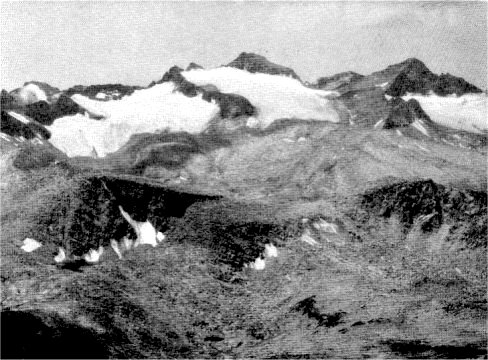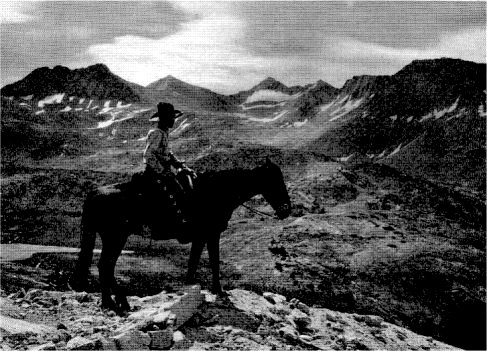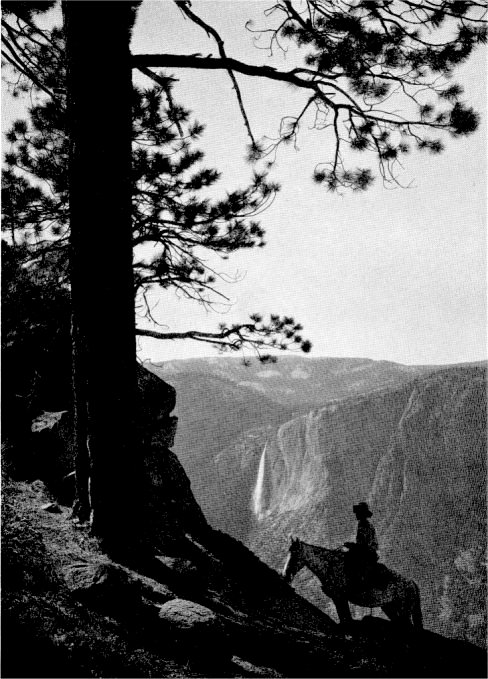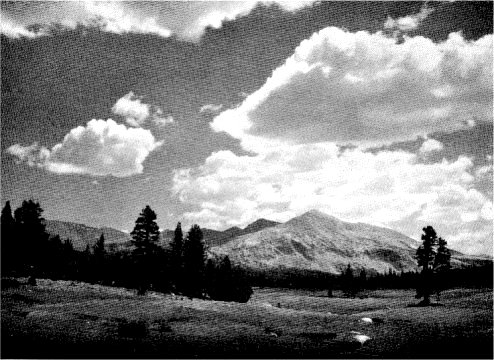
[click to enlarge]
Mount Dana, an empire of stark granite
peaks tumbled together in desolate grandeur
| Online Library: | Title | Author | California | Geology | History | Indians | Muir | Mountaineering | Nature | Management |
Yosemite > Library > Yosemite Tales & Trails > 7. Indian Legends >
Contents • Previous: Traveling the Trails
PRIMITIVE MAN has always had a reverence for stone. It was his first oracle and god, his first token of a life longer than his own. For man grasped the immortality of stone images before he dared dream of immortality for himself. Even today we make much of our Rock of Ages, our Gibraltar, our Sugar Loaf, our Diamond Head, and our pyramids.
So it is not surprising that the Indians should have deified Half Dome, El Capitan, and Sentinel Rock. Anything a savage can not understand he fears and worships. In his effort to explain the granite cliffs and the mountain peaks, woods, valleys, streams, and waterfalls, he peopled them with spiritual occupants, and attributed to them supernatural powers second only to those of the Great Spirit. And then about them he wove many legends.
Through many repetitions these legends have become so embroidered and embellished by the white man that only a flavor of the original remains. Included in the following pages are a few of the most characteristic of these stories still current in the Valley. And because the different versions of the same legend vary so in detail, in one or two instances a composite of the various accounts has been made, adhering always to the underlying motif, while risking the embroidering of one more eyelet in this fabric of fancy.
[Editor’s note: this “legend” “was almost certainly fabricated” according to NPS Ethnologist Craig D. Bates. It was first published in Hutchings “The Great Yo-Semite Valley” (1859) and reprinted in Hutchings Scenes of Wonder and Curiosity (1862) and In the Heart of the Sierras (1888) —dea.]
If you look closely upon the massive face of El Capitan, you will see there the fancied likeness of a man, in flowing robes, hastening westward. The Indians know him as Tu-tok-a-nu-la and have woven about him the following legend:
When the Great Spirit first made Ah-wah-nee, known today as Yosemite, and led the children of the sun into it, he placed the great god Tu-tok-a-nu-la on his granite tower as guardian of the Valley, to watch over and care for them.
Tu-tok-a-nu-la intervened with the Great Spirit to bring rains when they were needed to ripen the acorns and fatten the tender grass-roots. He drove the deer from their thickets that the hunters might bring home venison to their

[click to enlarge] |
|
Mount Lyell and Mount Maclure from
Mount Dana, an empire of stark granite peaks tumbled together in desolate grandeur |
Then one morning at dawn he heard a voice in the breeze, calling to him in tones as sweet as the ripple of water.
“Tu-tok-a-nu-la! ”
And as he looked in wonder, he saw, for a fleeting moment, a beautiful maiden, not like the dark children of Ah-wah-nee, but radiant and fair, with eyes blue as the mountain lakes, and hair golden as sunlight. Eagerly he reached out to her, but she vanished in a mist, and he knew her to be Tis-sa-ack, who dwelt upon Half Dome.
From that day he could think of nothing but this vision. As he roamed the mountain peaks and the forests, in search of her, neglect and desolation fell upon Ah-wah-nee. His people called to him in vain, imploring him to bring rain to revive the parched earth. The streams shriveled up and the fishermen returned empty-handed. No longer did the deer come from the mountains, and sickness and starvation came to the Ah-wah-nee-chees.
Still Tu-tok-a-nu-la forgot them. He was consumed only with a desire to see Tis-sa-ack once more. But she had vanished, and when she returned and saw the distress that Tu-tok-a-nu-la’s love for her had brought upon his people, her heart was heavy, and she called upon the Great Spirit to bring rain to Ah-wah-nee.
At once there came an answer to her prayer, for with a mighty crash the Great Spirit split in two the throne rock upon which she had stood, and water flowed from its sides, filling the streams and the Valley. And Tis-sa-ack’s tears flowed down the cleft rock, leaving at its foot a little lake, so that the streams might ever be replenished. And Tis-sa-ack was banished forever into the mists which often hover about her throne rock.
Tu-tok-a-nu-la returned at last from his vain searchings, and with his hunting-knife he carved his face upon El Capitan to show the people he had gone West again, always seeking his vanished Tis-sa-ack, leaving only his image to guard in his absence the Gates of Ah-wah-nee.

[click to enlarge] |
|
At Vogelsang Pass, high above
the timberline, the trail crosses the backbone of the Sierras |
And occasionally, it is said, just as the last rays of the sun creep over the crest of Half Dome, Tis-sa-ack comes back, wreathed in a cloud, to gaze once more into the valley she loved so well and to make sure that the children of Ah-wah-nee still live in peace and plenty.
Savages, it seems, were seldom able to trace to themselves the cause of their misfortunes, so they conveniently fixed the responsibilities and the sufferings upon the evil spirits. A spirit which had incurred the wrath of the Great Spirit was obliged to serve a term of expiation upon this earth. But if one of these demons could lure another to destruction, the victim had to serve as a proxy in place of the original, who was thus released to join his family.
Particularly dreaded by the Indians of Yosemite was that region directly below Bridal Veil Falls which was infested with those spirits. Even on the warmest days a capricious wind is often felt there, which the Indians called “Po-ho-no,” or “Evil Wind.” And while thousands of visitors pause there to admire the gossamer veil of spray, the Indian hurries past, face averted, a dread fear in his heart because of the following myth:
One soft spring day, while the women of Ah-wah-nee were gathering grasses for basket-weaving above the top of Po-Ho-No, or Bridal Veil Falls, one of the maidens ventured near the edge of the water to pick an overhanging grass. She stepped upon a mossy rock, set there to entrap her, by Po-Ho-No, the Evil One who inhabits the mist, and in a twinkling she was snatched into the falls never to return. Her companions, horrified, and fearing the same fate, hastened back to the Valley to spread the alarm. Instantly a band of young braves sped to the foot of the falls. But no sign of the maiden was to be found. Her spirit, with many others, was imprisoned in the water by Po-Ho-No, there to stay until she had lured some other victim to its doom, and not until then would it be released to wander on to the home of the Great Spirit in the West.
And that is why an Indian shudders as he feels the breath of Po-Ho-No upon

[click to enlarge] |
|
On the Glacier Point Trail one looks
down upon the top of Yosemite Falls and up towards mountains higher |
Mr. Bunnell, in his “Discovery of Yosemite” claims, however, that when the Mariposa Battalion first entered the Valley they found an Indian Village located not far from the foot of the falls. So he is inclined to think that their fear of the region occurred after that, and that the vicinity became haunted ground after the murder there of the two unfortunate miners, because of the death and disaster which promptly followed the commission of that crime.
[Editor’s note: this “legend” “is almost certainly fictitious” according to NPS Ethnologist Craig D. Bates. It was first printed in Hutchings In the Heart of the Sierras (1888) —dea.]
A little to the left of the upper Yosemite Falls, standing alone from the edge of the cliff, is a great shaft of granite rock which the Indians explained as follows:
It was the day of the marriage of Tee-hee-nay, fairest of Ah-wah-nee-chee maidens, to Kos-soo-kah, bravest of the warriors. But before the bride could go with the bridegroom to his lodge, there must be a great feast, and all day long Ah-wah-nee was astir with preparations.
Early in the morning Kos-soo-kah gathered about him the strongest of his young braves to hunt with him for the marriage feast. He parted from his beloved with the promise that, at the end of the day’s hunt, he would drop an arrow from the cliff above the falls. By the number of feathers it bore Tee-hee-nay should tell what the kill had been.
The day sped quickly while Tee-hee-nay and her women gathered acorns and young grasses, and when the long shadows stretched across the meadows she made her way with a light heart to the foot of Yosemite Falls to receive the message from Kos-soo-kah.
The shadows deepened to night, but still Tee-bee-nay received no sign from her lover. Becoming fearful, she climbed the cliff to meet him, and there, at the top of the cliff, she saw fresh footprints in the moist earth which led over the cliff—but failed to return!
Slowly she crept to the edge of the rock, and leaning far over she saw on a mound of fallen rock the motionless body of Kos-soo-kah, spent how in hand.

[click to enlarge] |
|
Dana Meadows on the Tioga Road, where
you will find “The four far corners of space, wind on the mouth, clouds in the face” |
By means of a signal fire she brought the old men from the Valley to her, and the young warriors from the woods, bearing on their backs Kos-soo-kah’s kill for the wedding feast. Slowly she was lowered over the cliff to his side, for she would allow no others to go.
As they were both raised to the cliff above, there beneath the stars of her wedding night she fell quietly forward upon his breast and the spirit of Tee-hee-nay followed that of Kos-soo-kah’s.
The arrow was never found, but in its stead appeared the granite shaft to the left of Yosemite Falls, in token of Kos-soo-kah’s last message to Tee-hee-nay, and it was called by the children of Ahwahnee Hum-mo, or Lost Arrow.
Long, long ago, before the Great Spirit had peopled Ahwahnee, an Indian woman, called Tis-sa-ack, and her husband, Nangas, left the plains of the Merced Valley to cross the high mountains before them. Weary from long days of climbing and laden with burdens, they reached Ah-wah-nee at last, parched for water, and eagerly they stumbled on to Ah-wei-ya, or Mirror Lake, to refresh themselves.
Tis-sa-ack, arriving first, set her papoose in its basket on the ground beside her and bending over drank thirstily from the lake. Again and again she filled her basket and drank deeply from it. So great was her thirst that by the time her husband arrived not a basketful of water remained.
In great anger, Nangas turned upon his wife and began to beat her. Tis-sa-ack in fright ran from him, but he pursued her, striking as he ran. At last in pain and humiliation Tis-sa-ack turned upon her husband and threw her burden-basket at him.
The Great Spirit, angered by all this tumult in his peaceful Ah-wah-nee, straightway turned them all to stone. Nangas became Washington Column. The upturned burden-basket, hurled by his weeping wife, became Basket Dome. The forgotten papoose, in his basket, became the Royal Arches, while Tis-sa-ack herself became that great monument, Half Dome, which is still streaked with the tears of shame which streamed down her face at her husband’s beating.
Just what relation this Tis-sa-ack has to the maiden of the other legend has never been explained, but the two stories run concurrently in the Valley today.
“When El Capitan was but a boulder,” is an expression sometimes heard in Yosemite. This refers to a time before Tu-tok-a-na distinguished himself among all the wild folk of Yosemite. El Capitan, according to legend, was not always the massive cliff it is today. Mythically speaking, it achieved its growth, as well as its name, in the following manner:
One warm, summer day, when there were only animal people in the world, two little bear cubs ran away from their home to go swimming. Scrambling out of the water they lay upon a warm rock to dry. The sun, and their swim, made them drowsy, and they soon fell fast asleep, in what later proved to be a regular Rip Van Winkle sleep. For while they were sleeping the rock upon which they lay began to grow. It grew and grew until it towered up into the very clouds, with the bear cubs asleep on its top.
When the mother bear learned what had happened she was overcome with grief. All the animals in the woods gathered about the foot of the great rock and each in turn tried to scale it. One after another they failed, even to the agile cougar and the powerful grizzly bear. Finally the Measuring-Worm, humblest of all the mountain people, began to climb up the face of the cliff. Inch by inch he made his way until he reached the top. There he found the bear cubs and took them back to their waiting mother. Overjoyed by the rescue, the animals hereafter called the cliff by the name of the valiant measuring-worm, and it is still known as Tu-tok-a-na.
A sequel to this story, no less amazing, is that Tu-tok-a-na, elated by his prowess, began now to “show off” a bit. He climbed again to the top of the cliff and stretching himself clear across the Valley drew himself over. Then he returned, repeating his acrobatics until he so weakened the walls of the Valley that they caved in, thus widening the canyon at this point quite noticeably!
Contents • Previous: Traveling the Trails
| Online Library: | Title | Author | California | Geology | History | Indians | Muir | Mountaineering | Nature | Management |
http://www.yosemite.ca.us/library/yosemite_tales_and_trails/indian_legends.html